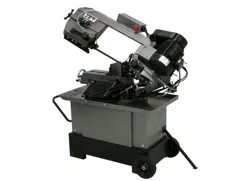Loading ...
Loading ...
Loading ...

11
7.6 Coolant system
Make sure there is coolant in
the tank before operating, to prevent damage to
pump.
Use of a water-soluble coolant will increase cutting
efficiency and prolong blade life. Do not use black
cutting oil as a substitute.
1. Remove coolant return hose (A, Figure 10)
from filter cup, and slide tank out of saw base.
2. Fill tank to approximately 80% of capacity. Full
capacity is 9 liters (2.25 gal).
3. Place tank into base. Place coolant return
hose into the filter cup. Verify that opposite
end of coolant return hose is connected to the
coolant pan.
4. The coolant supply hose (B, Figure 17) should
connect to the two valves on the blade guide
assemblies.
Figure 10
8.0 Electrical connections
Electrical connections must
be made by a qualified electrician in
compliance with all relevant codes. This
machine must be properly grounded to help
prevent electrical shock and possible fatal
injury.
The HVBS-710S Band Saw is rated at 115/230V
power, and pre-wired for 115 volt. The band saw
comes with a plug designed for use on a circuit
with a grounded outlet that looks like the one
pictured in A, Figure 11.
Before connecting to power source, be sure switch
is in off position.
It is recommended that the band saw, when
operated at 115 volt, be connected to a dedicated
20 amp circuit with a 20 amp circuit breaker or
time-delay fuse rated “D”. It is recommended that
the band saw, when operated at 230 volt, be
connected to a dedicated 15 amp circuit with a 15
amp circuit breaker or time-delay fuse rated “D”
Local codes take precedence over recom-
mendations.
8.1 Grounding instructions
1. All Grounded, Cord-connected Tools:
In the event of a malfunction or breakdown,
grounding provides a path of least resistance for
electric current to reduce the risk of electric shock.
This tool is equipped with an electric cord having
an equipment-grounding conductor and a
grounding plug. The plug must be plugged into a
matching outlet that is properly installed and
grounded in accordance with all local codes and
ordinances.
Do not modify the plug provided - if it will not fit the
outlet, have the proper outlet installed by a
qualified electrician.
Improper connection of the equipment-grounding
conductor can result in a risk of electric shock. The
conductor with insulation having an outer surface
that is green with or without yellow stripes is the
equipment-grounding conductor. If repair or
replacement of the electric cord or plug is
necessary, do not connect the equipment-
grounding conductor to a live terminal.
Check with a qualified
electrician or service personnel if the
grounding instructions are not completely
understood, or if in doubt as to whether the
tool is properly grounded. Failure to comply
may cause serious or fatal injury.
Use only 3-wire extension cords that have 3-prong
grounding plugs and 3-pole receptacles that accept
the tool's plug.
Repair or replace damaged or worn cord
immediately.
2. Grounded, cord-connected tools intended for
use on a supply circuit having a nominal rating less
than 150 volts:
This tool is intended for use on a circuit that has an
outlet that looks like the one illustrated in A, Figure
11. An adapter, shown in B and C, may be used to
connect this plug to a 2-pole receptacle as shown
in B if a properly grounded outlet is not available.
The temporary adapter should be used only until a
properly grounded outlet can be installed by a
qualified electrician. This adapter is not permitted
in Canada.
The green-colored rigid ear, lug, and the like,
extending from the adapter must be connected to a
permanent ground such as a properly grounded
outlet box.
3. Grounded, cord-connected tools intended for
use on a supply circuit having a nominal rating
between 150 - 250 volts, inclusive:
Loading ...
Loading ...
Loading ...
